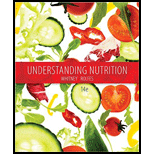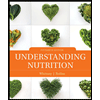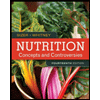
Concept explainers
To determine: Whether cranberry supplements help to prevent urinary tract infections.
Introduction: Phytochemicals are naturally occurring plant chemicals that are produced either through primary or secondary
To determine: Whether a phytochemical and/or functional food offers a safe and sensible solution to improve the health.
Introduction: Phytochemicals are naturally occurring plant chemicals that are produced either through primary or secondary metabolisms. In foods, phytochemicals impart colors, aromas, tastes, and other characteristics. Several phytochemicals have biological activity in the body. Functional foods are the enriched and enhanced foods that have a positive effect on health beyond the essential nutrients.
Want to see the full answer?
Check out a sample textbook solution
Chapter 13 Solutions
LMS Integrated for MindTap Nutrition, 1 term (6 months) Printed Access Card for Whitney/Rolfes Understanding Nutrition
- Discuss Concepts If you want to study factors that affect plant nutrition in nature, what would be the advantages and disadvantages of using a hydroponic culture method?arrow_forwardWhich is the better choiceto eat processed foods that have been enhanced with phytochemicals or to eat natural foods that are rich in phytochemicals?arrow_forwardBruce Ames and his colleagues have pointed out that although detailed toxicological analysis has been conducted on synthetic chemicals, almost no information is available about the mutagenic or carcinogenic effects of the toxins produced by plants as a natural defense against fungi, insects, and animal predators. Tens of thousands of such compounds have been discovered, and he estimates that in the United States adults eat about 1.5 g of these compounds each daylevels that are approximately 10,000 times higher than those of the synthetic pesticides present in the diet. For example, cabbage contains 49 natural pesticides and metabolites, and only a few of these have been tested for their carcinogenic and mutagenic effects. a. With the introduction of new foods into the U.S. diet over the last 200 years (mangoes, kiwi fruit, tomatoes, and so forth), has there been enough time for humans to develop resistance to the mutagenic effects of the toxins present in those foods? b. The natural pesticides present in plants constitute more than 99% of the toxins we eat. Should diet planning, especially for vegetarians, take into account the doses of toxins present in the diet?arrow_forward
- A secondary plant compound might be used for which of the following? a. a new crop variety b. a new drug c. a soil nutrient d. a crop pestarrow_forwardPhytochrome is a plant pigment protein that mediates plant infection promotes plant growth mediates morphological changes in response to red and far-red light inhibits plant growtharrow_forwardCompare a tap root system with a fibrous root system. For each type, name a plant that provides a food in the human diet. Which type of root system is found in monocots? Which type of root system is found in dicots?arrow_forward
- Most ____ are necessary for enzyme function. micronutrients macronutrients biomolecules essential nutrientsarrow_forwardDivide into two groups. One group will argue in support of using superfoods, and one group will argue against the use of superfoods. During the debate, be sure to answer the following questions: What is a superfood, and is it appropriate to classify a given food as a superfood? Are there foods that you can reliably say have the characteristics of a superfood? Describe the research you have consulted to support the classification of a food as a superfood.arrow_forwardWhich of the following statements is incorrect? a. Pigments absorb light of certain wavelengths only. b. Many accessory pigments are multipurpose molecules. c. Chlorophyll a is green because it absorbs green light.arrow_forward
- Carbon, hydrogen, and oxygen are _______ for plants. a. macronutrientsd b. micronutrientse c. trace elements d. required elements e. both a and b f. both a and darrow_forwardAt first glance, labeling appears to be a helpful way for consumers to make informed choices about the products they are buying. But given the lack of consensus on criteria to qualify as green, manufacturers have taken advantage of this marketing scheme and slapped eco-labels on a variety of products with little, or no, thought given to the environment. If you served on a labeling-regulation committee, what criteria would you propose in determining which, if any, food products and packages could claim to be environmentally friendly? How important is it for consumers to adopt environmentally friendly food behaviors?arrow_forwardIn 1976, a team of chemists in the United Kingdom was developing new insecticides by modifying sugars with chlorine Cl2, phosgene Cl2CO, and other toxic gases. One young Member of the team misunderstood his verbal instructions to test a newly made candidate substance. He thought he had been told to taste it. Luckily for him, the substance was not toxic, but it was very sweet. It became the food additive sucralose. Sucralose has three chlorine atoms substituted for three hydroxyl groups of sucrose table sugar. It binds so strongly to the sweet-taste receptors on the tongue that the human brain perceives it as 600 times sweeter than sucrose. Sucralose was originally marketed as an artificial sweetener called Splenda, but it is now available under several other brand names. Researchers investigated whether the body recognizes sucralose as a carbohydrate. They began by feeding sucralose labeled with 14C to volunteers. Analysis of the radioactive molecules in the volunteers urine and feces showed that 92.8 percent of the sucralose passed through the body without being altered. Many people are worried that the chlorine atoms impart toxicity to sucralose. How would you respond to that concern?arrow_forward
 Understanding Nutrition (MindTap Course List)Health & NutritionISBN:9781337392693Author:Eleanor Noss Whitney, Sharon Rady RolfesPublisher:Cengage Learning
Understanding Nutrition (MindTap Course List)Health & NutritionISBN:9781337392693Author:Eleanor Noss Whitney, Sharon Rady RolfesPublisher:Cengage Learning Biology: The Dynamic Science (MindTap Course List)BiologyISBN:9781305389892Author:Peter J. Russell, Paul E. Hertz, Beverly McMillanPublisher:Cengage Learning
Biology: The Dynamic Science (MindTap Course List)BiologyISBN:9781305389892Author:Peter J. Russell, Paul E. Hertz, Beverly McMillanPublisher:Cengage Learning- Nutritional Sciences: From Fundamentals to Food, ...Health & NutritionISBN:9781337486415Author:McGuirePublisher:Cengage
 Nutrition: Concepts and Controversies - Standalo...Health & NutritionISBN:9781305627994Author:Frances Sizer, Ellie WhitneyPublisher:Brooks Cole
Nutrition: Concepts and Controversies - Standalo...Health & NutritionISBN:9781305627994Author:Frances Sizer, Ellie WhitneyPublisher:Brooks Cole





